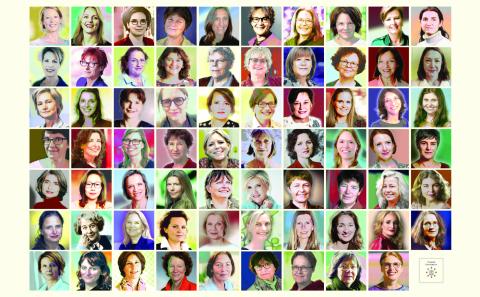Marianne van Hest
The Female Professors (2020, photography)
Cobbenhagen Building

Who are these female professors?
The very first female professor at Tilburg University was appointed in 1971. Madzy-Rood de Boer (1923-2009), a lawyer, subsequently spent 18 years at the university, where she laid the foundations for the current courses Family Law and Juvenile Law. Her appointment (initially as lecturer) took place exactly one century after the first woman was admitted to university in the Netherlands, the medical student Aletta Jacobs.
The number of women within science has increased since then, noting that the percentage gets lower as the position gets higher. For example, in 2019 at Tilburg University, 53% of PhD researchers were women, 45% ofassistant professors, 29% of associate professors, and of full professors the percentage was 23%. Tilburg upholds a target of 25%.
To achieve these targets, universities are looking at appointment procedures, mentoring programs have been developed, and Tilburg University has the Philip Eijlander Diversity Program. With this, 19 new positions have been created, at all scientific levels. The scientists involved work within the framework of the research agendas of the five Schools: Towards a Resilient Society, Health and Well-Being and Creating Value from Data.
The aim to appoint more women to senior positions is related to the idea of emancipation, which has characterized Tilburg University right from the start. The nature of the emancipating groups may have changed over the years, but the core idea is that higher education contributes to the development of groups of people for whom this has not always been obvious. The university was founded in 1927, as a result of the process of Catholic emancipation, which followed centuries of discrimination by the Protestant government. Consequently, it was mostly students from the southern provinces who attended this university. A second wave of emancipation came about as the university became increasingly accessible to students (men and women) who came from non-academic backgrounds. The last wave in this context consists of women in top-level scientific positions, as well as students and academic staff with origins other than exclusively Dutch.
Since Rood-De Boer's appointment, over sixty women have been appointed as full or associate professors at this university (the female professors of TiAS Business School are not included, as they are not employed by the university). All women, including those no longer connected to Tilburg University, were approached to make a portrait available for this portrait panel. Almost everyone participated, after which the portraits were edited by visual artist Marianne van Hest. By giving them a supporting color and by matching the sizes, a harmonious whole was created, which expresses the great importance that the university attaches to female scientists.
Who are these female professors?
Row 1: Marjolijn Antheunis, Caroline Baan, Hedwig van Bakel, Marrie Bekker, Inge Bongers, Antoinette de Bont, Brigitte Boon, Yvonne Brehmer, Evelien Brouwers en Barbara Deleersnyder.
Row 2: Diana Delnoij, Gerda van Dijk, Monique van Dijk-Groeneboer, Petri Embregts, Trix van Erp-Jacobs, Christina Feltz-Cornelis, Nicolette Gestel, Inge Geyskens, Els Gijsbrechts en Morag Goodwin.
Row 3 : Ien van de Goor, Stephanie van Gulijk, Anne-Wil Harzing, Odile Heynders, Edith Hooge, Mijke Houwerzijl, Maria Jacobs, Nicola Jägers, Dorien Kooij en Eleni Kosta.
Row 4: Monique Laurent, Saskia Lavrijssen, Marije van der Lee, Akeline van Lenning, Rianne Letschert, Helma van Lierop-Debrauwer, Katrien Luijkx, Vanessa Mak, Anne Meuwese en Dike van de Mheen.
Row 5: Lokke Moerel, Carol Ou, Lonneke van de Poll, Rachel Pownall, Martine Prange, Henriette Prast, Sacha Prechal, Corien Prins, Tine van Regenmortel en Mirjam van Reisen.
Row 6: Connie Rijken, Madzy Rood-de Boer, Mijntje Lückerath, Anne-Francoise Rutkowski, Christel Rutte, Juliette Schaafsma, Jantine Schuit, Maureen Sie, Margriet Sitskoorn, en Jenny Slatman.
Row 7: Renata Sotirov, Sigrid Suetens, Caroline Vander Stichele, Linette Taylor, Inge van Vijfeijken, Esther de Vries, Anja De Waegenaere, Tineke Willemsen en Eveline Wouters.
More about history and academic heritage
The Tilburg University academic heritage is a very diverse set of archives, visual materials, collections, devices, recorded stories, et cetera that relate to the history of the university.